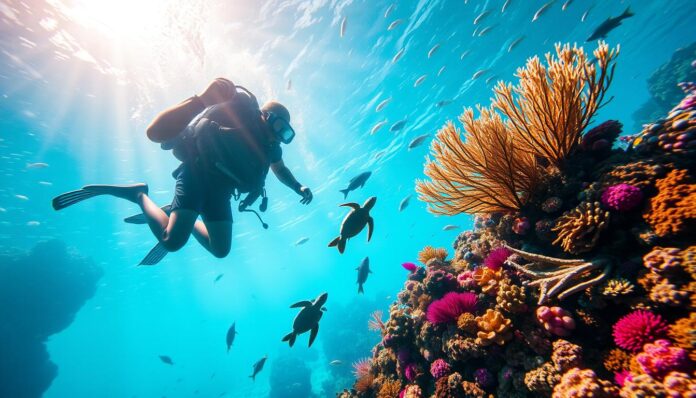| Best Time to Travel | April to October |
| What to Expect | Warm water, clear visibility, diverse marine life |
| Diving Conditions | Year-round, but best from April to October |
| Marine Life | Whale sharks, manta rays, turtles, sharks, dolphins, fish |
Are you ready to dive into the most biodiverse underwater paradise on Earth? Indonesia, with over 17,000 islands, offers an unmatched Scuba Diving in Indonesia experience. It turns your underwater exploration dreams into reality.
Indonesia is home to over 3,000 marine species and 600 coral species. It’s a true underwater wonderland. The Coral Triangle, within Indonesia, has more marine life than anywhere else, making it a dream spot for divers.
From the legendary Raja Ampat, known as the “Amazon of the Seas,” to Komodo National Park’s pristine waters, Indonesia has diving experiences for all. You can find beginner-friendly sites and challenging adventures for seasoned professionals.
Key Takeaways – Scuba Diving in Indonesia
- Indonesia hosts over 25% of global fish species
- Home to 600+ coral species across diverse dive sites
- Underwater exploration opportunities for all skill levels
- Unique marine biodiversity unmatched worldwide
- Multiple world-class diving destinations within one country
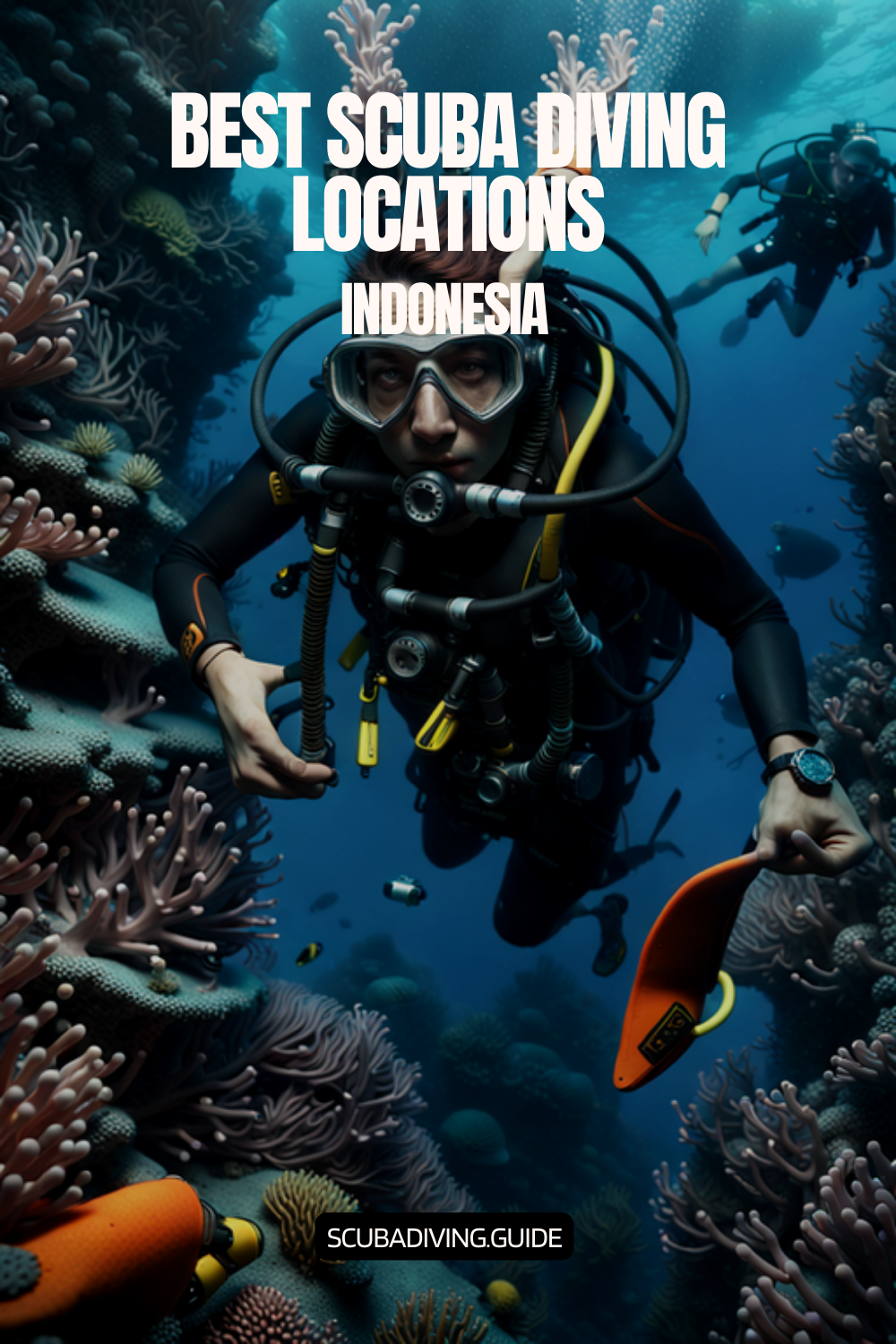
Why Indonesia is a Scuba Diving Paradise
Indonesia is a stunning underwater world, perfect for scuba diving. It’s in the Coral Triangle, known for its amazing marine life. This place draws divers from all over the world.
Unique Marine Biodiversity
Indonesia’s marine life is incredibly diverse. It has more than 3,000 fish species, beating even the Great Barrier Reef. Here, divers can see:
- Vibrant tropical fish
- Rare marine species
- Exotic underwater creatures
Stunning Underwater Landscapes
Indonesia’s underwater world is full of amazing sights. With 17,508 islands and 34,000 miles of coast, it offers many diving spots. You can dive in:
| Underwater Landscape | Unique Characteristics |
|---|---|
| Coral Gardens | Intricate reef systems |
| Dramatic Drop-offs | Steep underwater cliffs |
| Underwater Pinnacles | Massive rock formations |
Vibrant Coral Reefs
Indonesia’s coral reefs are truly amazing. They have 76% of the world’s coral species. The warm waters, between 26-30°C, make it perfect for diving.
“Indonesia is not just a destination; it’s an underwater universe waiting to be explored.” – Marine Exploration Magazine
With clear waters and diverse habitats, Indonesia is a top diving spot. It offers unforgettable underwater adventures.
Best Scuba Diving Locations in Indonesia
Indonesia is home to some of the world’s most amazing dive sites. It has an incredible marine ecosystem that draws divers from everywhere. With over 25% of the world’s fish and 72% of coral species, it offers unmatched diving experiences.
Exploring Indonesia’s underwater world is like entering a marine wonderland. It promises unforgettable adventures for all divers. Travel packages to these places offer a chance to see incredible marine life.
Raja Ampat: The Crown Jewel of Marine Biodiversity
Raja Ampat is a top dive spot, with 75% of the world’s coral species. Divers can find:
- Pristine coral reefs
- Incredible marine life diversity
- Crystal-clear waters
- Best diving season from October to April
Komodo National Park: A Diving Wonderland
This UNESCO World Heritage Site is known for its amazing dive sites. Highlights include:
- Vibrant coral reefs
- Manta ray encounters
- Potential Komodo dragon sightings
- Peak diving season between April and October
Bali: Diverse Underwater Experiences
Bali is Indonesia’s most popular diving spot, with something for everyone. Key attractions include:
- USAT Liberty Wreck in Tulamben
- Mola Mola (sunfish) sightings
- Year-round diving opportunities
- Best Mola Mola viewing from July to October
“Indonesia’s underwater world is a treasure trove of marine biodiversity waiting to be explored.” – Marine Conservation Expert
Each place offers unique dive sites and travel packages for different preferences and skill levels. Whether you’re new or experienced, Indonesia’s marine landscapes promise incredible underwater adventures.
Best Time to Go Scuba Diving in Indonesia
Indonesia is a paradise for scuba diving all year round, with its 17,000 islands. Knowing the best times to dive in different places can make your trip better. It also helps you see more marine life.
Weather Conditions and Diving Windows
The diving season in Indonesia changes by area. The dry season, from May to September, is best for most places. You can expect:
- Clear waters with up to 30 meters visibility
- Calmer seas
- Predictable weather
Marine Life Activity Insights
Each area has its own special marine life all year. Raja Ampat, for example, is full of life from October to April. Here, you might see:
- Manta rays in big numbers
- Whale sharks in Cenderawasih Bay
- Unique species like the epaulette shark
Strategic Timing to Avoid Crowds
Travel smart to avoid the crowds. Good tips include:
- Go during the shoulder seasons
- Choose less busy dive spots
- Book dives midweek
“The magic of Indonesian diving lies not just in where you dive, but when you dive.” – Professional Dive Instructor
Every diving spot has its own best time. Triton Bay is great from March to June and September to December. The Forgotten Islands are best from September to December.
Required Certifications for Scuba Diving
Scuba diving in Indonesia’s underwater worlds needs specific certifications. These ensure diver safety and fun. Knowing the right courses lets divers explore with confidence.
Open Water Diver Certification
The Open Water Diver certification is the first step for diving. It lets divers go up to 18 meters deep. It teaches essential skills for safe diving.
- Minimum age requirement: 10 years old
- Swimming proficiency: Ability to swim 200 meters without stopping
- Course duration: 2-4 days
- Maximum dive depth: 18 meters
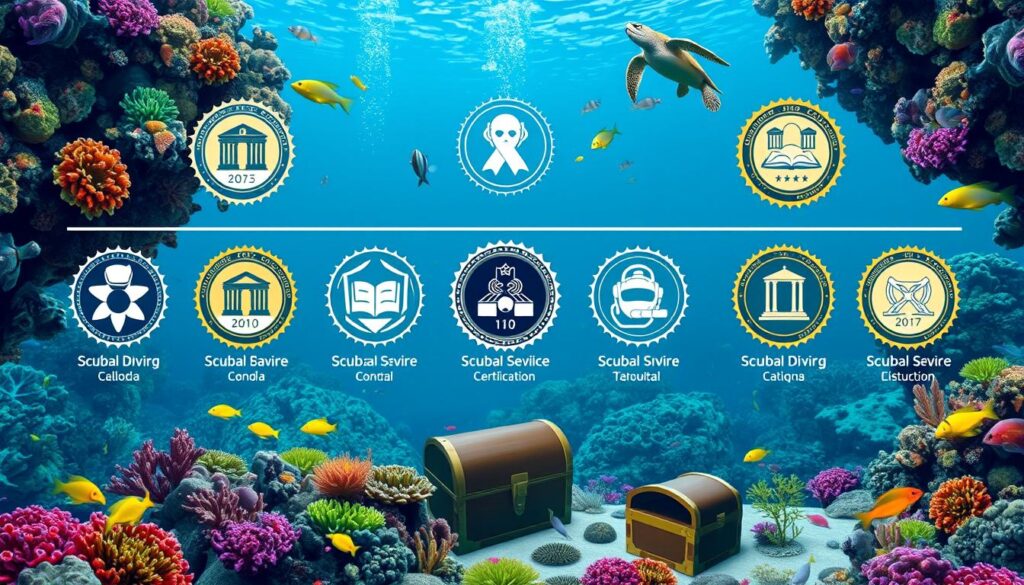
Advanced Diver Certification
The Advanced Open Water Diver certification is for those who want more. It prepares divers for deeper, more challenging dives. Places like Komodo’s strong currents are perfect for this.
| Certification Details | Specifications |
|---|---|
| Minimum Age | 12-15 years |
| Maximum Dive Depth | 30 meters |
| Course Duration | 2-3 days |
| Number of Dives | 5 specialized dives |
“Certification is not just a qualification, it’s your passport to underwater exploration.” – Professional Diving Instructor
Top groups like PADI, SSI, and NAUI offer courses in Indonesia. Open Water Diver courses in Bali cost between IDR 4,000,000 to IDR 6,000,000. This makes diving accessible to many.
Equipment Needed for Scuba Diving
Getting ready for an underwater adventure means picking the right dive gear. Whether you’re new to diving or have lots of experience, knowing the must-have equipment is key. It ensures your dive is both safe and fun.
Essential Dive Equipment Breakdown
Dive gear is vital for safety and comfort under the sea. Here’s what every diver needs:
- Mask: It’s like a window to the underwater world, and 90% of divers say it’s essential.
- Snorkel: About 70% of new divers use it for swimming at the surface.
- Fins: They can cut energy use by up to 35% while exploring underwater.
- Wetsuit: It’s key for keeping warm in water between 70°F and 85°F.
- Regulator: It’s the most important safety tool for breathing underwater.
Rental vs. Purchasing Dive Equipment
Choosing between renting and buying dive gear depends on several things. Most dive shops let you rent, but buying your own gear has big benefits.
| Equipment | Rental Cost | Purchase Recommendation |
|---|---|---|
| Mask | $10-$15 per day | Highly recommended to purchase |
| Fins | $15-$20 per day | Personal pair recommended |
| Dive Computer | $30+ per day | Worth personal investment |
“The right dive equipment can transform your underwater experience from good to extraordinary.” – Professional Diving Instructor
Having your own dive gear means a better fit and comfort. While things like scuba tanks are usually rented, owning a mask, snorkel, and fins can really improve your diving. It makes your dives more comfortable and effective.
In Indonesia, the different diving spots need specific gear. Think about the local water temperatures and the dive site’s needs when choosing your equipment. Focus on quality, fit, and comfort to fully enjoy your underwater adventures.
Common Marine Life to Spot
Indonesia’s underwater world is full of marine life. Divers will see an amazing variety of creatures. This makes Indonesia a paradise for those who love the sea.
Indonesia’s waters are home to many species. Each dive is a new adventure. You’ll see everything from small creatures to huge marine animals.
Colorful Fish Species
Indonesia’s coral reefs are alive with color. Divers will see many fish species:
- Clownfish darting between anemone tentacles
- Colorful parrotfish grazing on coral
- Napoleon wrasses with their distinctive bulbous heads
- Mandarinfish performing complex mating dances
Sharks and Rays
Indonesia is home to amazing shark and ray species:
| Species | Notable Characteristics | Typical Locations |
|---|---|---|
| Whale Sharks | Largest fish species, weighing up to 21.5 tonnes | Raja Ampat, Nusa Penida |
| Manta Rays | Graceful giants at cleaning stations | Komodo, Nusa Penida |
| Reef Sharks | White-tip, Black-tip, Gray Reef sharks | Deep waters around 90 feet |
Coral Gardens
The coral gardens of Indonesia are living ecosystems. They are full of unique marine life. Underwater photographers will find rare creatures like:
- Pygmy seahorses (measuring just 1.7 cm)
- Over 3000 species of nudibranchs
- Rare Wonderpus octopus
- Flamboyant cuttlefish with vibrant color displays
“Indonesia’s marine biodiversity is unparalleled, giving divers a glimpse into one of the most complex and beautiful ecosystems on our planet.”
Safety Tips for Scuba Diving
Scuba diving in Indonesia is an amazing adventure. But, safety comes first. The beautiful marine life, from Raja Ampat to Komodo National Park, needs careful planning and attention.
Checking Your Equipment
It’s vital to check your gear before diving. Make sure:
- Mask is free from cracks or damage
- Regulator works well
- Air tank pressure and connections are good
- BCD inflates and deflates as it should
Diving with a Buddy
Diving with a buddy is key in Indonesia’s waters. Always:
- Dive with a partner
- Share dive plans
- Keep in sight of each other
- Know emergency signals
Managing Your Air Supply
Strong currents in places like Komodo affect air use. Here’s how to manage air:
| Air Consumption Stage | Recommended Action |
|---|---|
| First Third of Tank | Explore normally |
| Second Third of Tank | Start heading back |
| Final Third of Tank | Move carefully, get ready to go up |
“In the underwater world of Indonesia, preparation saves lives.” – Professional Dive Instructor
Scuba diving in Indonesia demands respect for the sea and your safety. Always listen to local dive instructors and stay alert during your dive.
Understanding Dive Guides and Instructors
Scuba diving in Indonesia is more than just fun. It needs professional dive guides to make it safe and memorable. Their knowledge is key in Indonesia’s complex underwater world.
The Importance of Professional Guidance
Dive instructors are full of valuable knowledge. They know the local sea life, currents, and challenges in Indonesian waters. With them, you learn important skills and safety rules.
- Provide complete safety lessons
- Understand underwater conditions
- Know how marine life behaves
- Give quick help in emergencies
Selecting the Right Dive Guide
Finding the right dive guide is important. Look for those with recognized certifications and lots of local experience.
| Qualification Criteria | Recommended Standard |
|---|---|
| Professional Certification | PADI or similar international approval |
| Local Experience | At least 3 years in Indonesian waters |
| Language Skills | Must speak English well, local language is a plus |
| Safety Training | Has the latest emergency response training |
“A great dive guide turns a normal dive into an amazing adventure.” – Professional Diving Association
Choosing a well-qualified dive instructor is a smart move. It ensures your safety and makes your dive through Indonesia’s seas unforgettable.
Health Considerations While Diving
Scuba diving in Indonesia needs careful attention to health and safety. The tropical waters offer amazing underwater experiences. But, divers must be ready for challenges and emergencies.
Physical Fitness for Diving
Scuba diving in Indonesia requires being in top physical shape. The region’s diverse marine environments can be challenging, with strong currents.
- Maintain cardiovascular fitness
- Practice regular swimming exercises
- Develop core strength and flexibility
- Undergo medical check-ups before diving
Understanding Underwater Health Risks
Divers in Indonesia’s marine landscapes must know about health risks. These risks come from underwater activities.
| Risk Factor | Potential Impact | Prevention Strategy |
|---|---|---|
| Decompression Sickness | Nitrogen absorption in tissues | Follow dive tables, ascend slowly |
| Nitrogen Narcosis | Impaired decision-making | Limit depth, receive advanced training |
| Equipment Malfunction | Potential diving emergency | Regular gear inspection |
Emergency Preparedness
Scuba diving in Indonesia means being ready for emergencies. The buddy system is key for safety.
“Safety doesn’t happen by accident. It requires constant awareness and preparation.” – Diving Safety Expert
Always carry emergency devices, know basic first aid, and use dive safety equipment. Recommended vaccinations include routine, Typhoid, and Hepatitis.
- Carry a complete first aid kit
- Know emergency contact procedures
- Understand local medical facilities
- Purchase complete dive insurance
Remember, your health and safety are most important when exploring Indonesia’s underwater world.
Environmental Responsibility in Diving
Scuba diving lets us see the underwater world up close. But, it also means we must protect marine ecosystems. Environmental conservation is not just a phrase; it’s a vital mission for every diver in Indonesia.
Divers are key in keeping underwater habitats safe. By using sustainable practices, we can lessen our impact. This helps protect the marine life and biodiversity.
Sustainable Diving Practices
Responsible diving starts with knowing and using important conservation strategies:
- Collect at least one piece of debris per dive
- Use eco-friendly sunscreen with zinc oxide
- Practice perfect buoyancy control
- Avoid touching or disturbing marine life
Protecting Marine Ecosystems
Divers can help marine conservation in many ways:
| Conservation Activity | Impact |
|---|---|
| Underwater Cleanups | Removes marine debris and supports ecosystem health |
| Citizen Science Projects | Provides valuable data for marine research |
| Supporting Marine Protected Areas | Helps preserve critical marine habitats |
“Every dive is an opportunity to become a guardian of the ocean’s incredible ecosystems.”
The trend towards sustainable diving is on the rise. More diving operators now focus on environmental conservation. They offer experiences that are both eco-friendly and unforgettable.
By adopting these practices, divers can make sure Indonesia’s marine environments stay vibrant. They will remain healthy for future generations to explore and love.
Scuba Diving Courses in Indonesia
Indonesia is a top spot for scuba diving, with courses for all levels. You can dive in Bali’s clear waters or explore Raja Ampat’s remote sites. There are many training options for every skill level.
There are many certification paths for divers in Indonesia. Two big names lead the market:
- PADI (Professional Association of Diving Instructors)
- SSI (Scuba Schools International)
Popular Dive Training Locations
Indonesia has amazing places for learning to dive:
- Gili Islands – Great for beginners
- Bali Barat National Park – Perfect for newbies
- Raja Ampat – For those ready for more
Certification Course Pricing and Travel Packages
Prices for diving courses vary by location and course type. Travel Packages range from affordable to luxury.
| Course Type | Average Duration | Price Range (USD) |
|---|---|---|
| Open Water Diver | 3-4 days | $350-$500 |
| Advanced Open Water | 2-3 days | $300-$450 |
| Rescue Diver | 3-5 days | $400-$600 |
“Indonesia offers some of the most affordable and high-quality diving certification experiences worldwide.” – International Diving Magazine
Pro tip: Many dive centers offer package deals combining training with accommodation, making your diving adventure more cost-effective.
Liveaboard Diving Adventures
Discover the ultimate underwater journey through liveaboard diving in Indonesia’s stunning marine landscapes. These floating dive expeditions offer unique Travel Packages. They turn ordinary diving trips into extraordinary adventures across the world’s most diverse marine ecosystems.
Understanding Liveaboard Diving
A liveaboard is a special boat for multi-day diving experiences. It lets divers reach remote and pristine dive sites that day trips can’t. With Travel Packages from 7 to 12 nights, divers dive into Indonesia’s incredible underwater world.
Benefits of Liveaboard Experiences
- Access to remote dive locations like Raja Ampat and Komodo National Park
- Multiple daily diving opportunities
- Comprehensive underwater exploration
- Professional guidance and support
- Comfortable onboard accommodations
Popular Liveaboard Destinations
| Location | Best Months | Unique Features |
|---|---|---|
| Raja Ampat | October-April | Most biodiverse marine environment |
| Komodo | May-October | Warm water temperatures |
| Banda Sea | September-October | Hammerhead shark sightings |
“Liveaboard diving transforms your underwater experience from a simple trip to an extraordinary journey of discovery.” – Marine Exploration Experts
When choosing a liveaboard, think about group size, boat amenities, diving experience levels, and budget. Prices for Travel Packages range from €200 to €900 per day. This offers options for every budget and preference.
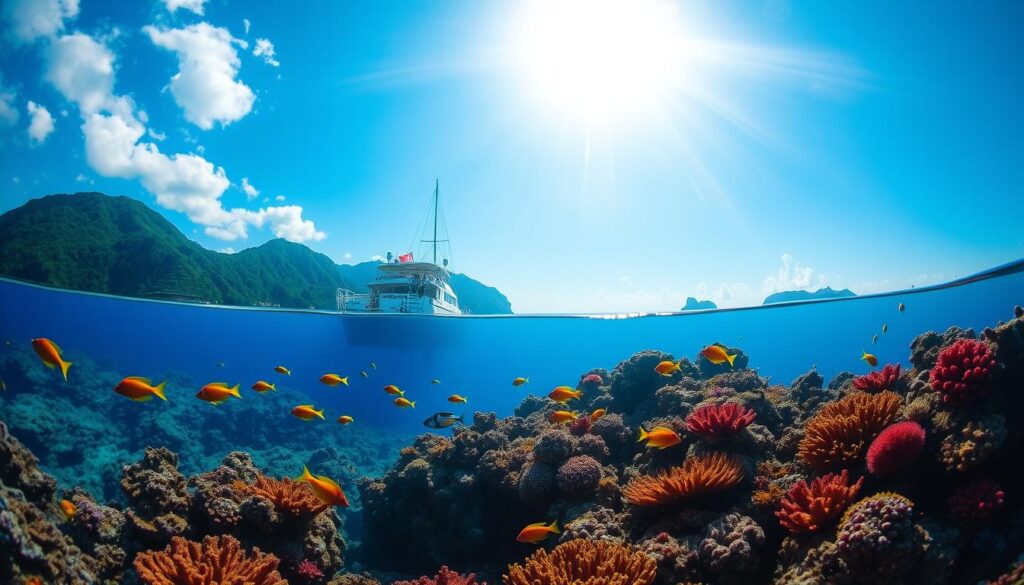
Get ready for an unforgettable marine adventure. Indonesia’s liveaboard trips offer unparalleled exploration of underwater wonders.
Dive Insurance: Do You Need It?
Scuba diving in Indonesia is full of amazing adventures. But, unexpected challenges can pop up underwater. Travel Packages for divers should include insurance to cover these risks and avoid financial surprises.
Diving comes with risks that regular travel insurance doesn’t cover. Both professional divers and hobbyists know how vital dive insurance is. It protects against underwater emergencies.
The Importance of Complete Coverage
Dive insurance is key for underwater explorers. Medical emergencies can be very costly:
- Emergency medical evacuations in remote Indonesia can cost up to $35,000
- Hyperbaric chamber treatments cost between $350 to $1,000 per hour
- Air evacuations can range from $10,000 to $20,000
Recommended Insurance Options
Many trusted groups offer dive insurance for Travel Packages in Indonesia:
- Divers Alert Network (DAN)
- World Nomads
- International SOS Assistance
“Dive insurance isn’t an expense, it’s an investment in your safety and peace of mind.” – Professional Diving Instructor
When picking dive insurance, make sure it covers:
- Dive accident incidents
- Hyperbaric chamber treatments
- Emergency medical evacuation
- Equipment protection
Indonesia’s underwater world is breathtaking. But, responsible divers know to protect themselves with complete insurance coverage.
Diving Regulations in Indonesia
Scuba diving in Indonesia has its own set of rules. These rules are in place to keep divers safe and protect the marine life. A law from 2016 says every diver must have an Indonesian guide with them. This rule makes solo diving illegal in the country.
Permits and Fees
Places like Komodo National Park and Bunaken Marine Park need special permits and fees. The cost depends on where you dive. These fees help protect the marine environment and support local efforts.
Divers should plan for these costs and get the right permits. This way, they can dive responsibly in Indonesia’s beautiful waters.
Respecting Local Guidelines
Indonesia’s dive rules focus on saving the marine ecosystem. Divers must not touch marine life, take souvenirs, or get too close to coral reefs. Dive centers could face big problems if they break these rules.
Responsible diving is key. It keeps Indonesia’s underwater world amazing for future explorers. Each dive spot has its own challenges, from Raja Ampat’s clear waters to Bali’s strong currents.
By following local rules, divers can have a safe and fun dive in Indonesia. It’s a way to enjoy the beauty of the sea while protecting it.
Indonesia Recommended Scuba Diving Itinerary
Planning a scuba diving trip to Indonesia can be an exciting and rewarding experience. With its vast array of dive sites spread across the archipelago, creating a well-rounded diving itinerary will ensure that you get to explore the best that Indonesia has to offer. Here’s a recommended scuba diving itinerary that highlights some of the most iconic and diverse dive locations in the country:
Day 1-3: Bali
Start your diving adventure in Bali, known as the Island of the Gods. Begin with exploring the shipwrecks off the coast of Tulamben, including the famous USAT Liberty wreck. Move on to the drift dives of Nusa Penida, where you can encounter majestic manta rays and the elusive Mola Mola (sunfish). Wrap up your Bali experience with a relaxing dive in the vibrant coral gardens of Amed.
Day 4-6: Komodo National Park
Fly to Labuan Bajo and embark on a liveaboard adventure to Komodo National Park. Dive the legendary sites of Batu Bolong and Crystal Rock, where you’ll be greeted by thriving coral reefs and an abundance of marine life. Explore the underwater landscapes of Manta Alley, where encounters with graceful manta rays are almost guaranteed. Don’t miss the chance to spot Komodo dragons, the largest lizards on Earth, during a visit to Rinca Island.
Day 7-10: Raja Ampat
Fly to Sorong and set sail to the breathtaking region of Raja Ampat. Spend your days exploring the unparalleled biodiversity of Misool, Wayag, and Cape Kri. Immerse yourself in the kaleidoscope of colors created by the vibrant coral reefs and encounter an array of marine life, including schooling fish, reef sharks, and turtles. Don’t forget to indulge in some topside activities, such as kayaking through hidden lagoons or trekking to panoramic viewpoints.
Day 11-14: Wakatobi
Fly to Wakatobi, a remote and pristine marine paradise. Dive into the crystal-clear waters and explore the incredible diversity of coral species in this UNESCO World Biosphere Reserve. Encounter fascinating macro life, including pygmy seahorses, ghost pipefish, and colorful nudibranchs. Take advantage of the calm conditions for night dives, where you can witness the mesmerizing transformation of the reef as nocturnal creatures emerge.
Day 15-17: Bunaken
Fly to Manado and head to Bunaken, a marine park renowned for its vertical walls and rich marine biodiversity. Dive into the clear waters to discover a stunning variety of coral formations and encounter an abundance of reef fish, turtles, and even barracudas. Take a break from diving to explore the picturesque landscapes of Bunaken Island and enjoy the tranquil surroundings.
Day 18-20: Gili Islands
Fly to Lombok and make your way to the Gili Islands. Dive the thriving coral reefs surrounding Gili Trawangan, Gili Air, and Gili Meno. Encounter sea turtles, reef sharks, and an array of tropical fish species. Explore the underwater sculptures of the Nest and experience the vibrant atmosphere of the Gili Islands, with their white sandy beaches and lively beachfront bars.
This recommended scuba diving itinerary provides a diverse and immersive experience, showcasing the unique underwater wonders of Bali, Komodo National Park, Raja Ampat, Wakatobi, Bunaken, and the Gili Islands. However, it’s important to note that the itinerary can be customized based on personal preferences, time constraints, and diving certifications.
Before embarking on your diving adventure, ensure that you have the necessary certifications and dive experience required for each location. It’s also recommended to dive within your limits and follow the guidance of experienced dive professionals.
With this scuba diving itinerary, you can uncover the hidden gems of Indonesia’s underwater world and create unforgettable memories that will last a lifetime.
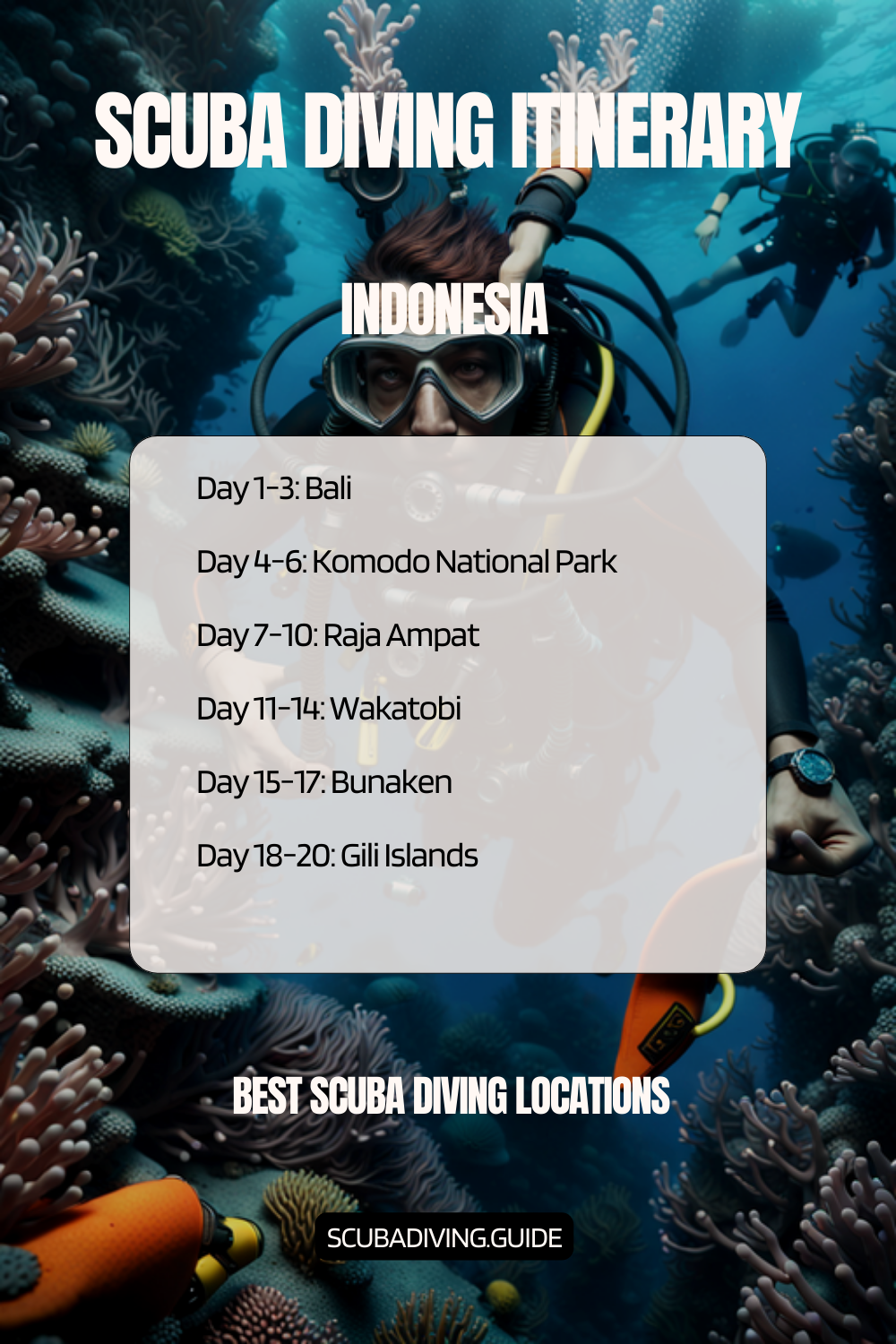
Other Countries to Consider
FAQ – Scuba Diving in Indonesia
Do I need prior diving experience to dive in Indonesia?
Indonesia has diving spots for all levels. Beginners can start in Bali. Experienced divers can explore Komodo National Park. Many dive centers offer courses for new divers.
What is the best time of year to go scuba diving in Indonesia?
The best diving season is April to October. Raja Ampat is best from October to April. Komodo is best from April to November. Each place has its own best time for diving.
What marine life can I expect to see while diving in Indonesia?
Indonesia’s waters are full of life. You might see manta rays, whale sharks, and colorful fish. Raja Ampat is home to over 1,500 fish species and 537 coral species.
What certifications do I need to dive in Indonesia?
You need at least an Open Water Diver certification. Komodo requires an Advanced Open Water certification. Dive centers offer courses to upgrade your skills.
Is scuba diving in Indonesia expensive?
Diving in Indonesia is affordable. Prices start at $30-$50 per dive. Liveaboard trips cost $200-$300 per day. Bali offers great value for money.
What safety precautions should I take while diving in Indonesia?
Dive with a certified guide and use the buddy system. Check your equipment and follow local guidelines. Be aware of currents and maintain buoyancy control. Dive insurance is important.
Do I need to bring my own diving equipment?
Many dive centers rent equipment. Experienced divers might bring their own. Rental equipment is high-quality for beginners.
How can I contribute to marine conservation while diving?
Dive responsibly by avoiding contact with marine life. Choose eco-friendly operators. Participate in reef clean-ups or marine research.
What type of dive insurance should I get?
Look for dive insurance that covers medical evacuation and injuries. DAN offers plans for international diving.
Are liveaboard trips worth it in Indonesia?
Liveaboard trips are great for remote sites like Raja Ampat and Komodo. They offer daily dives and access to pristine locations. They are more expensive but offer unique experiences.
